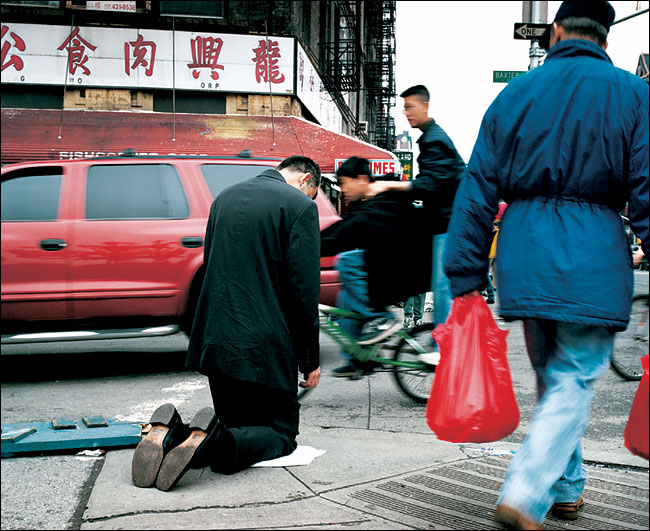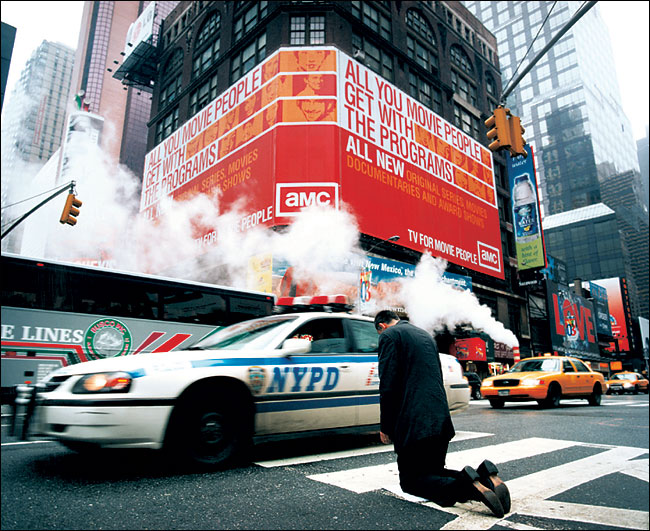Croatian Artists Set Their Sights on New York
By CAROL KINO
Published in The New York Times: June 23, 2005
Rich in artists but relatively bereft of international galleries and collectors, the countries of the former Yugoslavia have yet to develop a strong art market. To get in on the action and gain international recognition for their work, some of their artists have decided that the logical first step is to infiltrate New York.

Christian Nguyen
A photograph from a series showing the Croatian artist Zlatko Kopljar at some of the sites that have shaped his imaginative life. Mr. Kopljar is one of a number of artists from the former Yugoslavia trying to attract international attention to their work.

Christian Nguyen
Another photograph from the series.
Among those leading the way is the Croatian artist Andreja Kuluncic, who is amassing material for a semi-serious guide to the New York art world.
Ms. Kuluncic, one of this year's artists in residence at the nonprofit exhibition space Art in General in TriBeCa, arrived in the United States in April and began canvassing local curators, dealers, artists and collectors for their opinions on what constitutes art-world success and how best to attain it. The results of her research are on view at Art in General through Saturday, and through July 15 by appointment.
Her advice manual, "A Dummies' Guide to the New York Art World," which will also incorporate research conducted in Croatia, is to be published in December. "The guide is cynical," Ms. Kuluncic cautioned visitors who attended her opening presentation at Art in General. "It is not really a way to be successful."
Cynical or not, international recognition is a pressing issue for Croatia, long recognized as a cultural hotbed of the former Yugoslavia. Today, its artists sell their work primarily through Western European galleries or to Croatian museums, some of which are planning expansions and have begun to pursue contemporary work more aggressively.
Ms. Kuluncic, 36, who has shown her work at European art fairs like Documenta, Manifesta and the Liverpool Biennial, as well as at the Whitney Museum of American Art, said that Croatia's application for membership in the European Union had lent momentum to the artists' quest for international attention.
"Because we are entering the E.U., we are thinking about what we have to offer - in all fields as well as in art," she said.
Recently, too, as art-world buzz has developed around the formerly Communist countries of Eastern Europe, international curators have come hunting. "We don't want to be colonized," Ms. Kuluncic said. "Curators come and they already know what they want to see, and we don't want that. We have to make a market where we can sell what we already have."
What Croatia does have in abundance, says Roxana Marcoci, a curator at the Museum of Modern Art in New York, is performance, video and installation art. "Right now there is a lot of continuity with the sort of avant-garde tradition that was alive during the Socialist republic," said Ms. Marcoci, who in 2002 organized "Here Tomorrow," a huge survey of contemporary Croatian art, for the Museum of Contemporary Art in Zagreb.
"There are occasions when you see painting and sculpture, but that's not the main bulk of work. A lot of it is video-based and performance-based, or institutional critique. There are also many collaborative groups."
Croatia has had a strong video scene since the 1970's: several of its artists, including Sanja Ivekovic and Dalibor Martinis, are considered pioneers of the movement. Work like Ms. Kuluncic's, which tends to combine sociological investigation and political activism with multimedia elements and the written word, is also fairly typical. So are performances, like those of Slaven Tolj, known for body art that pushes the limits of physical endurance.
During the fighting in the Balkans in the 1990's, Croatia experienced something of a creative diaspora as some artists decamped for Vienna or Budapest, or for Italy, Germany, the Netherlands or the United States. Now many have returned, bringing with them fresh information and contacts, while others have developed transnational careers.
For artists, misconceptions are one legacy of the war in the former Yugoslavia, which involved many different ethnic and national groups. When curators and critics come to the Balkans, Mr. Martinis said, "they are not ready to see work like Bill Viola's, or some sort of cool conceptual art."
"People expect to see a messy, not too clear kind of work that has more to do with temperament and ethnicity," he said.
At the Croatian Pavilion at this year's Venice Biennale, the artist Tomo Savic Gecan is exhibiting a line of text that notes how visitors to a gallery in Amsterdam might affect the temperature of a swimming pool in Estonia.
While this focus on process and the evanescent moment makes arresting exhibitions, it can be tough to package for the market. "The gallerists know their rules," said Sandra Sterle, a multimedia artist based in Split, Croatia, "and you have to apply them if you want to sell. The rules of the gallery are rather similar to those of the boutique."
In 2004, Ms. Sterle sold her first piece to an American collector through Galerie Jablonka in Cologne: the DVD component of her installation "On the Dune," based on a performance in which she pours paint on a canvas spread on the beach, Ć la Jackson Pollock.
Recently, the dealer urged Ms. Sterle to formally mount a group of new photographs, rather than pinning them to the wall, to make them more salable. She refused. "I don't see why I should apply these rules for every piece," she said.
Like the other countries of the former Yugoslavia, Croatia had a strong and lively avant-garde for most of the 20th century. The advent of Communism after World War II allowed the art scene to develop without an emphasis on market profit, yet Tito's maverick government allowed many artists to travel abroad frequently and keep abreast of developments elsewhere.
After Tito's death in 1980, on through the civil war in the early 1990's and the authoritarian, nationalistic rule of President Franjo Tudjman, which ended in 1999, these freedoms were sharply curtailed.
Today, said Katherine Carl, a curator at New York's Drawing Center who is writing a doctoral dissertation on early Yugoslav conceptual art, "There is a very strong pool of artists all over the former Yugoslavia.
"But it's economically and politically different in all the different areas because of the breakup of the different countries," she said.
Slovenia, which achieved independence without extensive fighting, is generally regarded as the furthest ahead in terms of infrastructure for artists. It played host to Manifesta in 2000 and today boasts at least two commercial contemporary galleries that work the international art fair circuit. Meanwhile, the contemporary art sectors of Serbia, Montenegro, Macedonia, and Bosnia and Herzegovina are struggling.
Having emerged from a recession and gained a more moderate government, Croatia is chafing at the bit. "In both Croatia and Slovenia, people are reaching out," Ms. Carl said. "But in Croatia they've had to make the channels more diligently."
In addition, the country's troubles and its lack of an art market have in some ways given its artists a special tenacity and a deep sense of purpose. "When somebody is really young, it's much better to make work without market," said Zlatko Kopljar, 43, who finished art school in Venice in 1991, around the time the fighting in Croatia began. "If you don't get anything and still you are making art, that means you really want to do it; you really want to communicate. I couldn't give up, and I know a lot of people who didn't, believe me."
Mr. Kopljar made the first sale of his life in 2004, when an American collector spotted his work at the SĆ£o Paulo Biennial: a suite of photographs that picture Mr. Kopljar kneeling, head bowed, before some of the sites that have shaped his imaginative life - the United Nations, the Solomon R. Guggenheim Museum and Times Square.
Essentially, that sale - and others since - "changes nothing," Mr. Kopljar said. "But now I have sold a little bit of work, I can feel a little bit more relieved. I am not in existential cramps."
"Whether that's good or bad," he added, "I cannot say."
http://www.nytimes.com/2005/06/23/arts/design/23balk.html